Sometimes we talk about artists in their late (and still prolific) maturity as young artists to be discovered. It happens when looking at the exhibition by Giuliana Balice (1931) at the Fondazione Sabe, an institution born in Ravenna about a year ago and already become a point of reference in the neglected field of contemporary sculpture, thanks to the excellent work of Artistic Director Pasquale Fameli and a scientific committee of high value. The exhibition Equilibri instabili, curated by Italo Tomassoni, tells a very articulate story. Entering the exhibition halls, it’s obvious that Balice is part of neo-concretism, a context that after World War II recovered the desire for pure forms of the avant-gardes of the early 20th century.
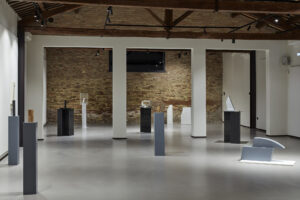
Overall view of the exhibition Giuliana Balice. Equilibri instabili, at Fondazione Sabe per l’Arte, 2023, photo Daniele Casadio, courtesy Fondazione Sabe, Ravenna
Without ever departing from that calibrated and regular creative world, the artist, who moved from Naples to Milan in the early 1960s, finds ever compelling ways to give a vital breath to her geometries. In this she seems to renew the imaginative impulses of the Russian Constructivists, whom Tomassoni quotes among her points of reference, but she updates them, encountering imagery that seems to be the offspring of those distant utopias. Observe Torre anomala (1972), a small architectural dream that is echoed in certain projects of the BBPR studio, such as the building (1967-1970) in the Corso Buenos Aires area of Milan known for its apartments jutting out according to steps of various heights and sizes.
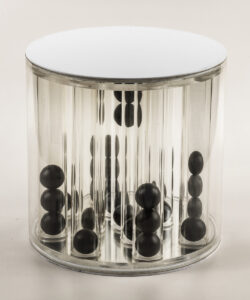
Giuliana Balice, Senza titolo, 1971, transparent methacrylate and opaque black methacrylate, 30 x 30 x 30 cm, photo by Sante Castignani, courtesy Fondazione Sabe, Ravenna
Balice in Milan became interested in other artists and formations of the neo-concretist area (such as Grazia Varisco and Gruppo T), but his research remained rather solitary, taking freely cues and inheritances. In work from 1971 (Senza titolo), for instance, a series of spheres peek out from the Plexiglas tubes of a larger cylindrical structure: the artist is familiar with Optical and kinetic art research, so strong at the time; yet rather than exploiting the principles of visual ambiguity or even the actual mechanical movement typical of those achievements, Balice introduces more nuanced and less “programmable” effects.
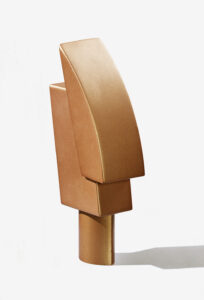
Giuliana Balice, Due ori si incontrano, 1993, varnished wood (sketch), 20 x 7 x 7 cm, photo by Daniele Casadio, courtesy Fondazione Sabe, Ravenna
Giuliana Balice’s objects are never closed in on themselves, but willingly open to a narrative dimension. Faced with works such as Due grigi si incontrano (1993) or Due ori si incontrano (1993) one even evokes the lyricism of a Brancusi, perhaps imagining the profile of the Due ori as the evolution of one of his Oiseau, born, however, from the meeting of regular forms as in a Leo Lionni fairytale. The variable interaction with the respective media also ensures that Balice’s works do not remain circumscribed to their essential physicality, as do poetics close to Minimalism.
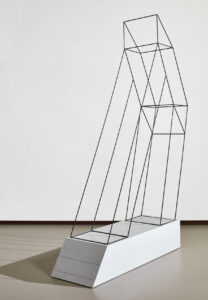
Giuliana Balice, Delfica, 1990, painted steel rod and wood, 200 x 120 x 35 cm, photo by Daniele Casadio, courtesy Fondazione Sabe, Ravenna
To understand this, one only must look at the soaring Delfica (1990), capable right from its title of evoking ancient mythologies: its linear steel rod pattern draws a kind of ramp for space launches, or perhaps a vaguely humanoid shape that advances while holding on to two pylons, like a manga robot. Or the graphic outline of another curious bird, as shown in the later Dal triangolo (2011), which is a kind of armored version of it. While moving within the compulsory measures of geometry, Giuliana Balice has the imagination of children who with small toys imagine great feats (Allunaggio di un prisma, 2005) and often models in new ways the formal solutions already adopted, perhaps recovering a base and assigning it the role of protagonist (Equilibrio instabile – Una torre per Olimpia, 2001).
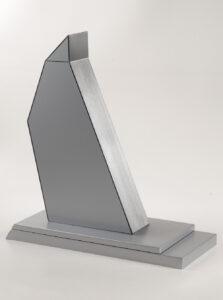
Giuliana Balice, Dal triangolo, 2011, steel and methacrylate, 34 x 25 x 13 cm, photo by Sante Castignani, courtesy Fondazione Sabe, Ravenna
Italo Tomassoni, who will tell the artist’s journey at the Fondazione Sabe on Thursday, March 9, spoke of a “Balice case”. Certainly, the Ravenna exhibition is an opportunity to rediscover a production of the highest level and surprising longevity, which deserves to be considered with more than passing attention.
Pierluca Nardoni
Info:
Giuliana Balice. Equilibri instabili
curated by Italo Tomassoni
14.01.2023 – 01.04.2023
Fondazione Sabe per l’Arte
via Pirano, 7, 48122 Ravenna
sabeperlarte.org

is a contemporary art magazine since 1980




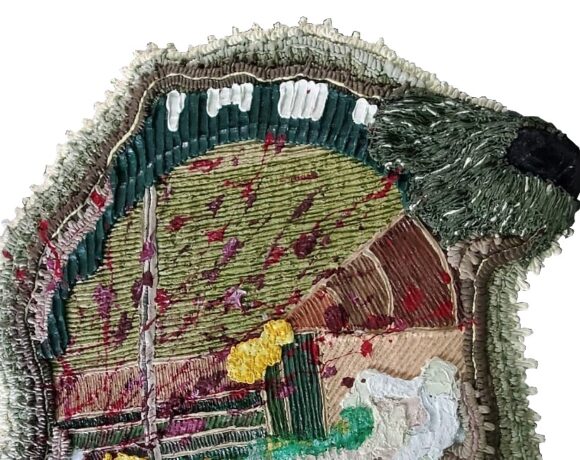

NO COMMENT